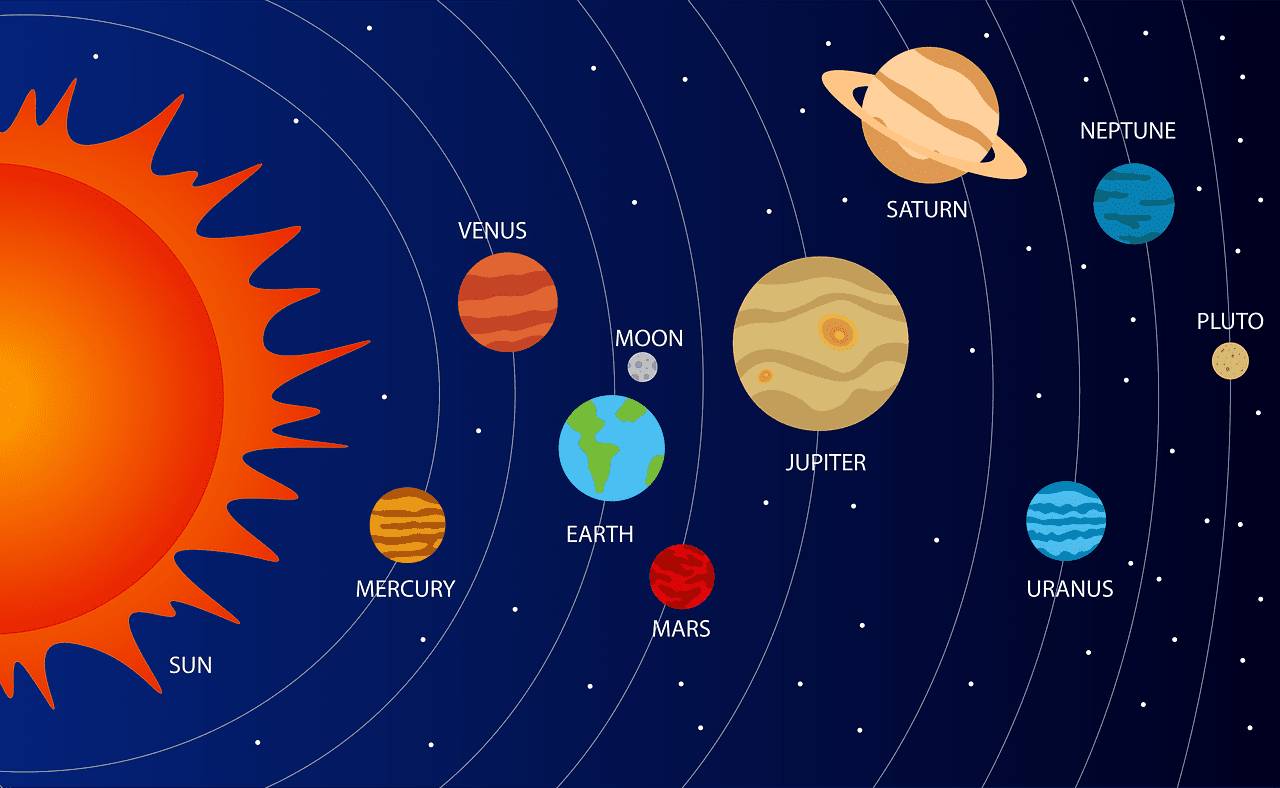**The Solar System: A Cosmic Neighborhood**
The Solar System, our celestial neighborhood, is a vast and complex structure governed by the gravitational pull of the Sun. It is home to the Sun, eight planets, their moons, dwarf planets, asteroids, comets, and countless other objects. Stretching across billions of kilometers, this system has fascinated humanity for centuries, and our understanding of its wonders continues to evolve.
The Sun: The Center of it All
At the heart of the Solar System is the Sun, a massive, burning ball of hydrogen and helium that accounts for over 99% of the system's total mass. The Sun is a star, like the countless others we see in the night sky, but it holds special significance for Earth, as its light and heat make life possible on our planet. It generates energy through nuclear fusion, converting hydrogen into helium and releasing immense amounts of energy in the process. This energy radiates outwards, fueling everything from the weather systems on Earth to the auroras on other planets.
The gravitational force of the Sun keeps the planets in orbit, preventing them from drifting into the vast emptiness of space. Without the Sun's gravity, the Solar System would not exist as we know it. The Sun itself is part of a larger galaxy, the Milky Way, which contains hundreds of billions of stars.
The Eight Planets: Diverse Worlds
The Solar System's planets are generally divided into two categories: terrestrial planets and gas giants.
1. **Terrestrial Planets**: These are the four inner planets closest to the Sun—Mercury, Venus, Earth, and Mars. They are small, rocky worlds with solid surfaces. Each has unique characteristics that set it apart.
- **Mercury** is the smallest planet and closest to the Sun, with extreme temperature fluctuations.
- **Venus** is similar in size to Earth but has a thick, toxic atmosphere of carbon dioxide, making it the hottest planet.
- **Earth** is the only known planet with life and has a balanced atmosphere of nitrogen and oxygen.
- **Mars**, the "Red Planet," is known for its iron-rich soil, frozen ice caps, and the possibility that it once had liquid water.
2. **Gas Giants**: The outer planets—Jupiter, Saturn, Uranus, and Neptune—are vastly different from the inner planets. These gas giants lack solid surfaces and are composed mainly of hydrogen and helium.
- **Jupiter** is the largest planet, with a powerful magnetic field and dozens of moons, including the volcanic moon Io and the ice-covered Europa.
- **Saturn** is famous for its stunning ring system made of ice and rock. It also has many moons, including Titan, which has a thick atmosphere and liquid methane lakes.
- **Uranus** is unique in that it rotates on its side, possibly due to a collision with another object long ago. Its atmosphere contains methane, giving it a blue-green hue.
- **Neptune**, the most distant planet, also appears blue due to its methane atmosphere. It is known for strong winds, some of the fastest in the Solar System.
Dwarf Planets and Other Objects
Beyond Neptune lies a region known as the Kuiper Belt, home to many icy bodies, including **Pluto**, once considered the ninth planet. In 2006, Pluto was reclassified as a dwarf planet, a category that includes other objects like Eris, Haumea, and Makemake. These dwarf planets share characteristics with both asteroids and larger planets but do not meet all the criteria to be considered full-fledged planets.
Further out is the **Oort Cloud**, a distant, spherical region that may contain trillions of icy objects. Comets, which often originate in the Oort Cloud, occasionally get pulled towards the inner Solar System, developing bright tails as they approach the Sun and their icy surfaces vaporize.
Moons: Natural Satellites
Many planets have moons, and their diversity is as impressive as the planets themselves. Earth's **Moon** is the only natural satellite of our planet, influencing tides and stabilizing Earth's rotation. Jupiter and Saturn, however, boast the largest collections of moons, with over 80 each. Moons like Saturn's **Titan** and Jupiter's **Ganymede** (the largest moon in the Solar System) are worlds of interest for scientists, as some may harbor the conditions necessary for life.
Asteroids and Meteoroids
Between Mars and Jupiter lies the **Asteroid Belt**, a region filled with rocky remnants from the early Solar System. These objects, ranging in size from small pebbles to large bodies like Ceres (a dwarf planet), may hold clues to how the Solar System formed. Occasionally, asteroids are knocked out of their orbits and can come close to Earth. If they enter Earth’s atmosphere, they are called meteoroids, and if they survive the journey to the surface, they are known as meteorites.
The Solar System's Future
The Solar System is constantly evolving. Over billions of years, the Sun will burn through its hydrogen fuel, eventually expanding into a red giant and swallowing the inner planets. Beyond that, the Solar System's fate is tied to the long-term future of the galaxy itself.
Though the Solar System as we know it is just a tiny part of the universe, its study offers profound insights into the nature of space and time. From the blazing heat of the Sun to the icy depths of the Kuiper Belt, the Solar System is a rich and varied collection of celestial wonders, reminding us of the vastness and beauty of the cosmos.


